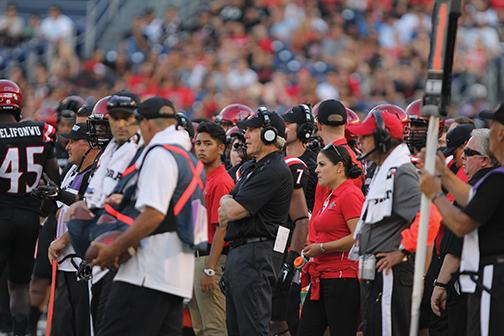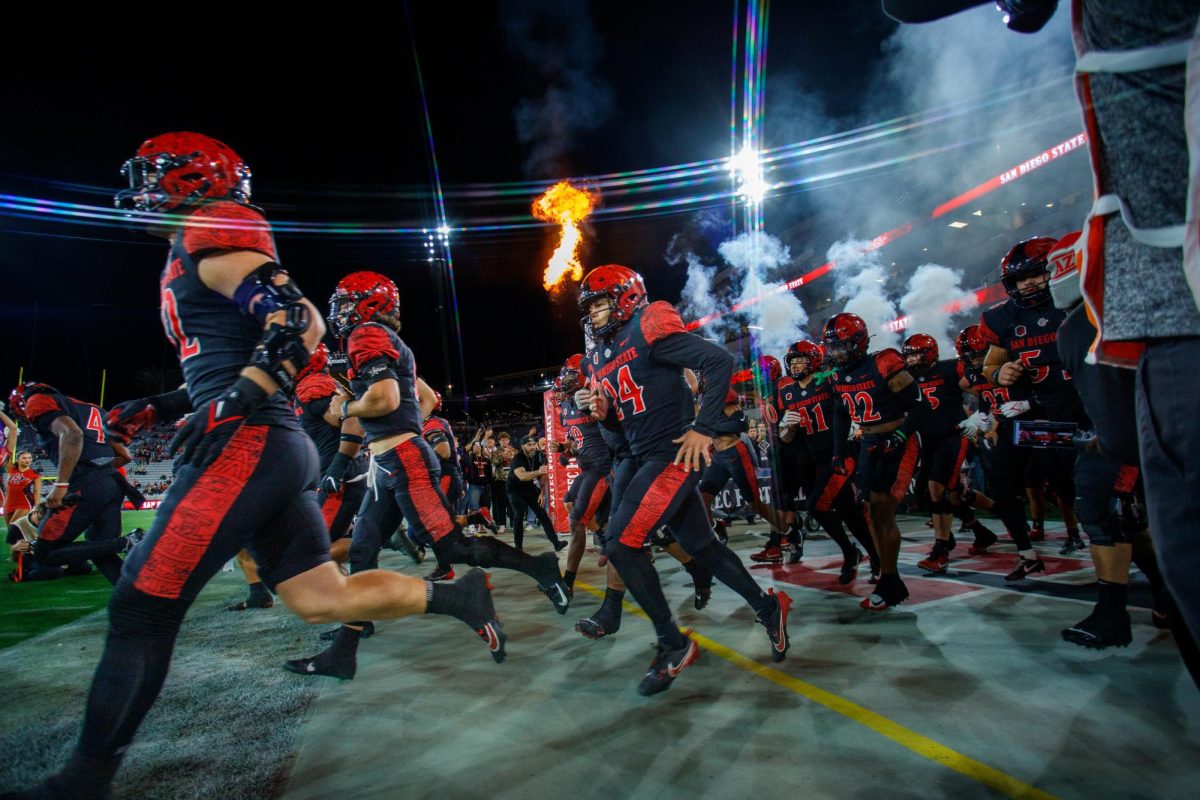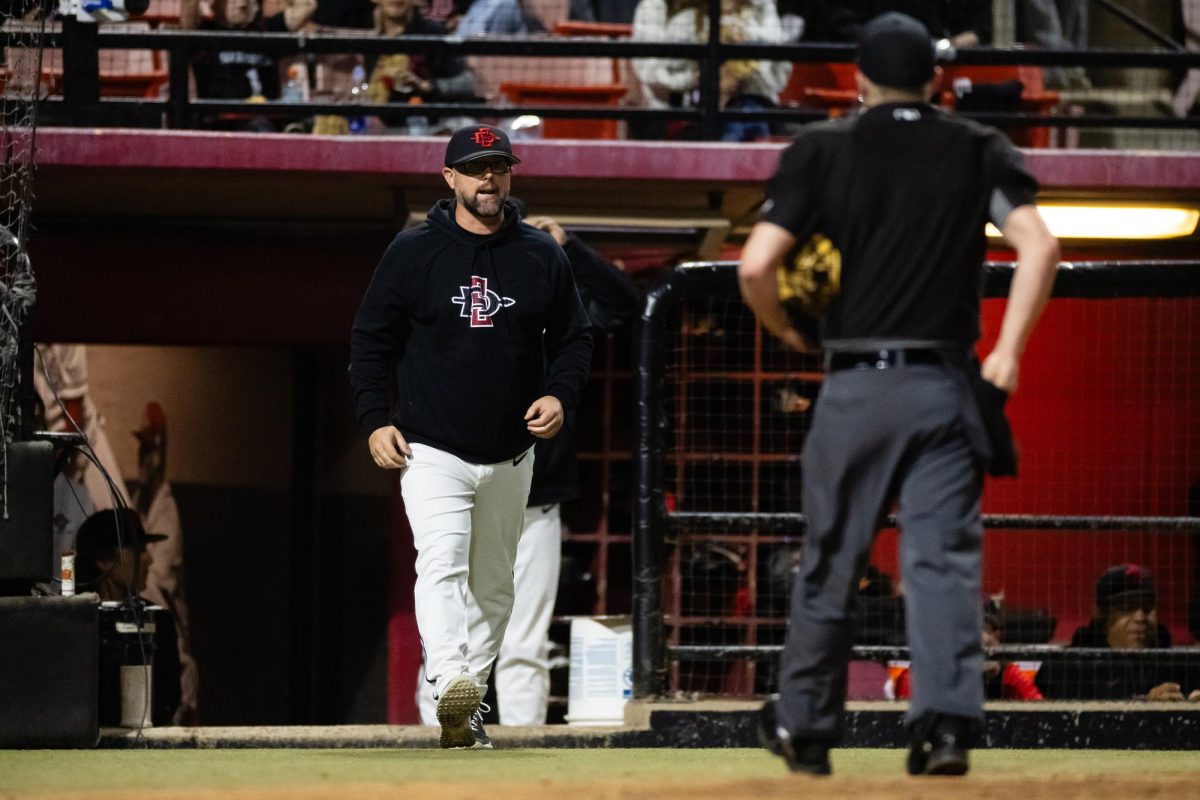The night after Halloween had a scary ending for the San Diego State football team after another solid defensive outing was clouded by inconsistent offense.
I know, I know — you’ve seen me write about play-calling woes a few times this season already. But the inconvenient truth is that the Aztecs’ offense continues to become stagnant in games after starting red-hot.
Against the University of Nevada, Reno Wolf Pack on Saturday, SDSU senior quarterback Quinn Kaehler started the game completing five of five passes for 52 yards, including a 23-yard throw to get the Aztecs in the red zone on the team’s second possession.
One play later, sophomore standout running back Donnel Pumphrey fumbled the ball in the middle of a gain. Deflating? Yes, but not the end of the world.
Keep trying to pound the ball, Aztecs.
But they didn’t. Instead, the Aztecs threw the ball and although Kaehler moved the team, the drives stalled and didn’t result in many scores.
Consider this: Kaehler attempted 36 passes and the Aztec backfield combined for 25 total carries. Against the Wolf Pack, the Aztecs used six different players to run the ball including wide receivers Lloyd Mills and Ezell Ruffin. That’s an average of four carries per player, which is too thinly spread out to create any consistency in the running game. Pumphrey led the team in carries with 13, which is five less than what he’s averaging on the season.
It’s understandable that Pumphrey didn’t get too many carries. After all, he did fumble twice in situations that both proved to be costly for the team. It was a rare night when Pumphrey wasn’t going to be the workhorse for SDSU’s offense, which is why it’s important to have a reliable second-string running back.
The Aztecs have one in sophomore Chase Price, who showed power and speed on multiple runs including a one-yard touchdown carry. It was the only rushing touchdown of the night for SDSU.
Price finished the game with eight carries for 58 yards and the touchdown. His 7.3 yards-per-carry average was nearly a whole yard better than Pumphrey’s, yet he only got to carry the ball eight times the entire night. It’s frustrating to watch a player have success and then disappear for unapparent reasons.
It’s even more frustrating because for a good portion of the game, the Aztecs were protecting a lead. Heading into the fourth quarter, the team was ahead by one point despite Pumphrey’s two fumbles and a Kaehler interception.
Correct me if I’m wrong, but it doesn’t seem as if the defense is what’s costing SDSU tight games this season.
“But Ethan, the defense gave up 17 points in the fourth quarter,” you’ll say. “Isn’t that why we lost the game?”
Technically speaking, yes. Two big runs both came on plays where the Aztecs’ safeties got out of position. One of them was a 43-yard touchdown.
But it’s important to put things in context, so here we go.
Nevada started its late scoring run when SDSU squandered an opportunity after intercepting Wolf Pack senior quarterback Cody Fajardo late in the third quarter. The Aztecs started the drive at their own 37-yard line and three plays later punted from their own 40.
The Wolf Pack drove down the field but was held to a field goal, putting them up 16-14.
It was crunch time for the Aztecs, who needed to sustain a long drive and put points on the board. Unfortunately, they gained seven yards on another three-play drive composed of one run and two throws. SDSU punted and Nevada scored a touchdown on the following drive.
Down by nine with about five minutes left in the game, it was make-or-break for SDSU. A first-down run was followed by a sack on second down and a botched snap on third down.
Not clutch, Aztecs.
Even worse is none of those three drives lasted longer than three minutes, possibly contributing to the defense’s fatigue late in the game. The total time of possession was in Nevada’s favor by almost five minutes.
If the Aztecs are going to win the Mountain West Conference, the offense has to help the defense by calling better plays and executing at a high level. If it doesn’t, SDSU will be looking up at conference foes they lost to in winnable games at the end of the season.







